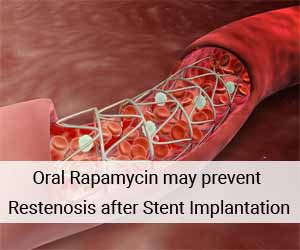- Home
- Editorial
- News
- Practice Guidelines
- Anesthesiology Guidelines
- Cancer Guidelines
- Cardiac Sciences Guidelines
- Critical Care Guidelines
- Dentistry Guidelines
- Dermatology Guidelines
- Diabetes and Endo Guidelines
- Diagnostics Guidelines
- ENT Guidelines
- Featured Practice Guidelines
- Gastroenterology Guidelines
- Geriatrics Guidelines
- Medicine Guidelines
- Nephrology Guidelines
- Neurosciences Guidelines
- Obs and Gynae Guidelines
- Ophthalmology Guidelines
- Orthopaedics Guidelines
- Paediatrics Guidelines
- Psychiatry Guidelines
- Pulmonology Guidelines
- Radiology Guidelines
- Surgery Guidelines
- Urology Guidelines
Oral Rapamycin may prevent restenosis after Coronary bare metal Stent implantation: JACC

Restenosis is one of the major challenges faced by cardiologists and patients after coronary angioplasty. A study published in the Journal of the American College of Cardiology revealed that administration of oral rapamycin during 14 days after Coronary Bare-Metal Stent Implantation significantly reduces angiographic and clinical parameters of restenosis.
Rapamycin is a macrolide compound that is used to coat coronary stents, prevent organ transplant rejection and to treat a rare lung disease called lymphangioleiomyomatosis.
It is a potent immunosuppressive and antiproliferative agent that was approved by the U.S. Food and Drug Administration (FDA) for use in patients after renal transplantation. Systemic use of rapamycin and its analog were associated with a significant reduction of intimal hyperplasia tested in animals, but only recently its oral administration was studied.
The present controlled, randomized study, carried out by Alfredo E. Rodriguez et al aimed at determining whether short oral administration of the drug was associated with a reduction of restenosis in patients treated percutaneously with bare metal stent therapy of de novo lesions.
The authors randomized 100 patients to either oral rapamycin (6-mg loading dose given 2.7 h before intervention followed by 3 mg/day for 14 days) plus diltiazem 180 mg/day or no therapy after the implantation of a coronary bare metal stent design, Between September 2003 and September 2004. The primary study endpoint was the incidence of angiographic binary restenosis and late loss at nine months. The secondary endpoints were target lesion revascularization, target vessel revascularization, and incidence of major adverse cardiovascular events at 1 year.
Key findings of the study
- Angiographic follow-up was completed in 87% of patients.
- In the rapamycin group, the drug was well tolerated (26% minor side effects) and was maintained in 96% of patients.
- At 9 months, the in-segment binary restenosis was reduced by 72% and the in-stent binary restenosis was reduced by 65%.
- The in-segment late loss was also significantly reduced with oral therapy.
- At 1 year, patients in the oral rapamycin group also showed a significantly lower incidence of target vessel revascularization, target lesion revascularization, and major adverse cardiovascular events.
On the basis of the findings, the authors concluded that administration of oral rapamycin during 14 days after stent implantation significantly reduced angiographic and clinical parameters of restenosis. Clinical safety and efficacy parameters of restenosis, such as TVR, TLR, and MACEs at follow-up were also significantly improved with oral Rapamycin therapy.
For further reference, click on the link
DOI: 10.1016/j.jacc.2005.12.052

Disclaimer: This site is primarily intended for healthcare professionals. Any content/information on this website does not replace the advice of medical and/or health professionals and should not be construed as medical/diagnostic advice/endorsement or prescription. Use of this site is subject to our terms of use, privacy policy, advertisement policy. © 2020 Minerva Medical Treatment Pvt Ltd